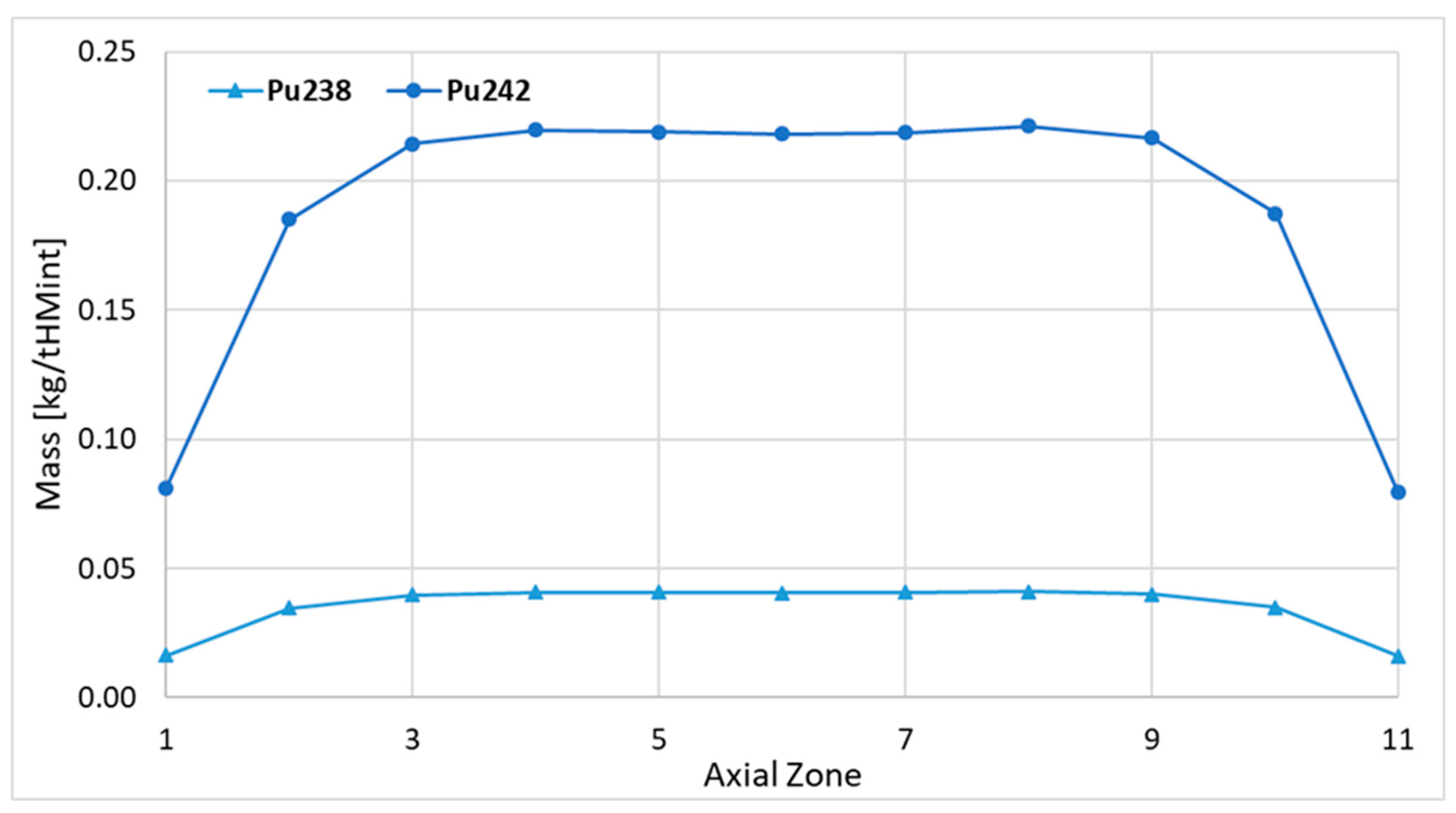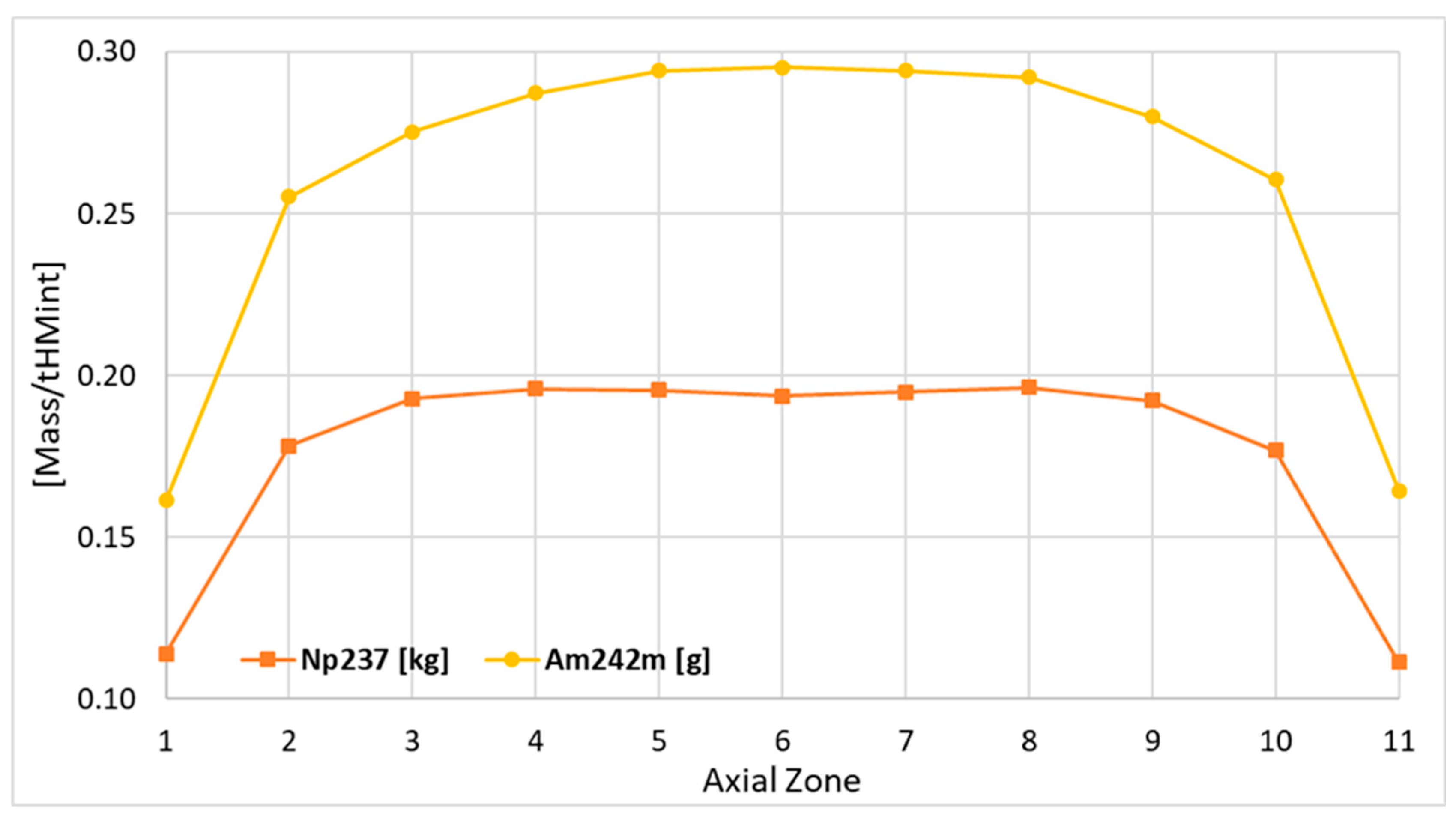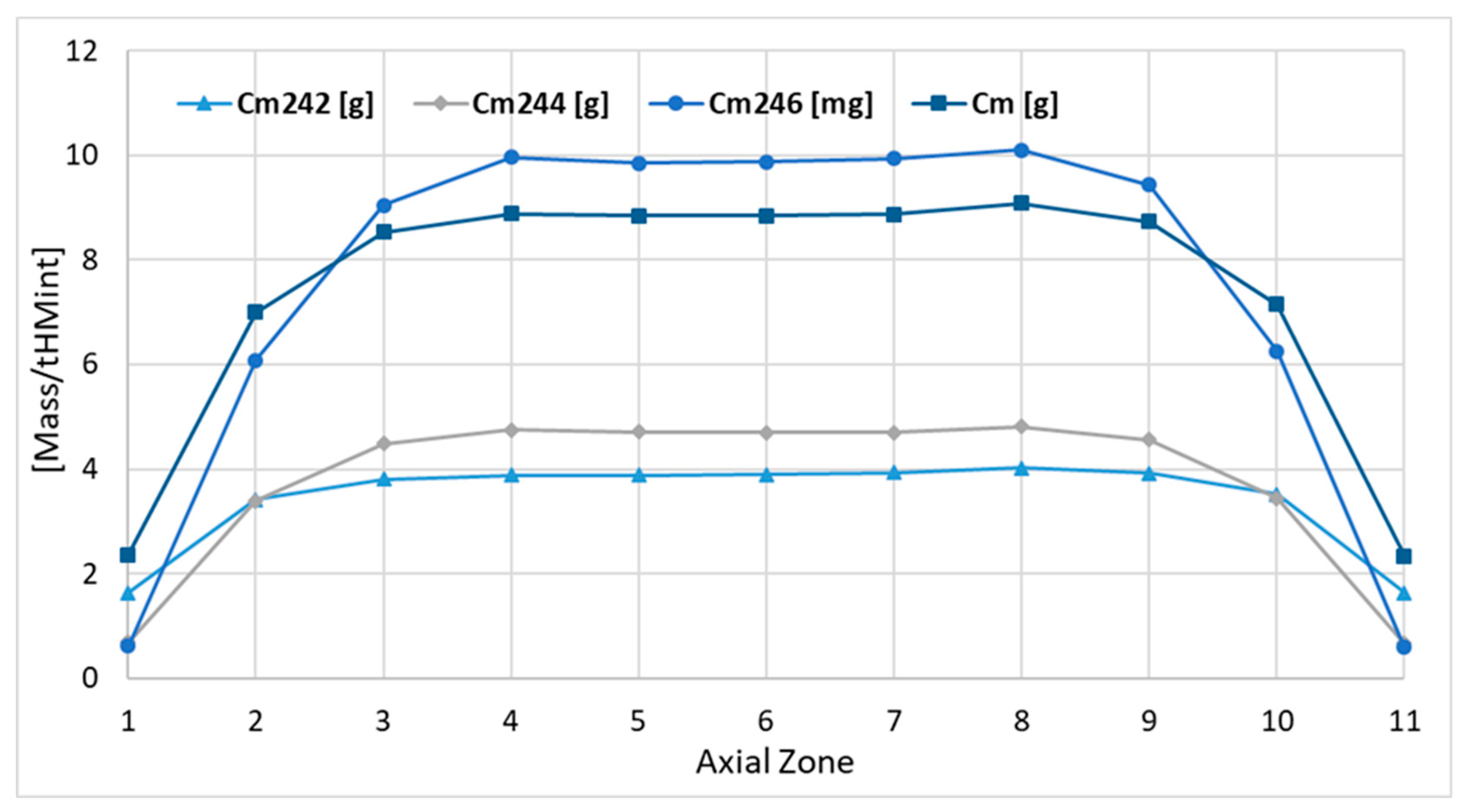Monte Carlo Modeling of Isotopic Changes of Actinides in Nuclear Fuel of APR1400 Pressurized Water Reactor
Abstract
:1. Introduction
2. Materials and Methods
2.1. Numerical Model
2.2. Numerical Calculations
3. Results
3.1. The Actinide Build-Up
3.2. The Evolutions of the Actinides
3.3. Radial Distribution
3.4. Axial Distribution
4. Discussion
5. Conclusions
- (a)
- The modeling of uranium fuel utilization using the developed numerical model is characterized by improved reliability due to the application of the real design and operational data.
- (b)
- The reliability of the obtained results is increased by the use of the MCB code, which is a well-validated tool for the modeling of isotopic changes in the PWR cores.
- (c)
- The spatial and time resolutions of the numerical model were designed using the best practices indicated by reactor designers, and are suitable for the current study.
- (d)
- The numerical model and the whole modeling methodology are flexible and can be easily adjusted to other analyses related to reactor core design and safety estimation.
- (e)
- The build-ups of actinides depend on their transmutation and decay chains from the gateway isotope 238U; the highest masses were obtained for the plutonium isotopes and the lowest for the curium isotopes.
- (f)
- The radial distribution of actinides varies by the isotope and depends on the fuel enrichment in 235U, the content of gadolinia burnable absorber, and the geometrical location of the burnup zones in the core.
- (g)
- The axial distribution of actinides at the EOC depends on total neutron fluence; the lowest concentrations were obtained close to the top and bottom reflector, and the highest in the burnup zones near the core center (zones 4 and 8).
- (h)
- The concentrations of the transuranic isotopes were all monotonically increasing and had not yet reached equilibrium in the 17.571 GWd/tHMint of burnup.
Supplementary Materials
Author Contributions
Funding
Data Availability Statement
Acknowledgments
Conflicts of Interest
References
- Lee, S.S.; Kim, S.H.; Suh, K.Y. The design features of the advanced power reactor 1400. Nucl. Eng. Technol 2009, 41, 995–1004. Available online: https://www.kns.org/files/jour/v41/JK0410995.pdf (accessed on 1 September 2024). [CrossRef]
- Yu, H.; Yahya, M.S.; Kim, Y. A reduced-boron OPR1000 core based on the big T burnable absorber. Nucl. Eng. Technol. 2016, 48, 318–329. [Google Scholar] [CrossRef]
- International Atomic Energy Agency. Advanced Reactors Information System, Status Report—APR1400 (KEPCO E&C/KHNP). 2020. Available online: https://aris.iaea.org/PDF/APR1400_2020May.pdf (accessed on 1 September 2024).
- Nuclear Energy Agency. Organisation for Economic Co-Operation and Development, Multinational Design Evaluation Programme, APR1400 Working Group, Design Description and Comparison of Design Differences between APR1400 Plants, Technical Report, TR-APR1400-01. 2018. Available online: https://cms.oecd-nea.org/mdep/documents/TR-APR1400-01%20Design%20Description%20and%20Comparison%20of%20Design%20Differences.pdf (accessed on 1 September 2024).
- International Atomic Energy Agency. Nuclear Power Reactors in the World, Reference Data Series No. 2, IAEA-RDS-2/43; International Atomic Energy Agency: Vienna, Austria, 2023; ISBN 978-92-0-137123-2. ISSN 1011-2642. [Google Scholar]
- International Atomic Energy Agency. The Power Reactor Information System. Available online: https://pris.iaea.org/pris/ (accessed on 1 September 2024).
- Lamarsh, J.R.; Baratta, A.J. Introduction to Nuclear Engineering, 3rd ed.; Prentice Hall: Upper Saddle River, NJ, USA, 2021; ISBN 0-201-82498-1. [Google Scholar]
- Nuclear Energy Agency. Organisation for Economic Co-Operation and Development, The Economics of the Back End of the Nuclear Fuel Cycle, NEA No. 7061, Nuclear Development. 2013. Available online: https://www.proquest.com/openview/e8af3b81ceb9285b84dee1c145cbc2f7/1?pq-origsite=gscholar&cbl=2026412 (accessed on 1 September 2024).
- Alhattawi, N.T.; Alrwashdeh, M.; Alameri, S.A.; Alaleeli, M.M. Sensitivity neutronic analysis of accident tolerant fuel concepts in APR1400. J. Nucl. Mater. 2023, 582, 154487. [Google Scholar] [CrossRef]
- Alrwashdeh, M.; Alameri, S.A. Preliminary neutronic analysis of alternative cladding materials for APR-1400 fuel assembly. Nucl. Eng. Des. 2021, 384, 111486. [Google Scholar] [CrossRef]
- Salam, M.; Hah, C.J. Comparative study on nuclear characteristics of APR1400 between 100% MOX core and UO2 core. Ann. Nucl. Energy 2018, 119, 374–381. [Google Scholar] [CrossRef]
- Do, M.; Nguyen, X.H.; Jang, S.; Kim, Y. Physics study for high-performance and very-low-boron APR1400 core with 24-month cycle length. Nucl. Eng. Technol. 2020, 52, 869–877. [Google Scholar] [CrossRef]
- Alrwashdeh, M.; Alameri, S.A. A neutronics study of the initial fuel cycle extension in APR-1400 reactors: Examining homogeneous and heterogeneous enrichment design. Arab. J. Sci. Eng. 2023. [CrossRef]
- Khalefih, H.; Oh, T.; Jeong, Y.; Kim, Y. LEU+ loaded APR1400 using accident tolerant fuel cladding for 24-month two-batch fuel management scheme. Nucl. Eng. Technol. 2023, 55, 2578–2590. [Google Scholar] [CrossRef]
- Khalefih, H.; Kim, Y. Feasibility study of a two-batch soluble-boron-free APR-1400 reactor. In Proceedings of the Transactions of the Korean Nuclear Society Virtual Spring Meeting, Daejeon, Republic of Korea, 13–14 May 2021. [Google Scholar]
- Alnaqbi, J.; Hartanto, D.; Alnuaimi, R.; Imron, M.; Gillette, V. Static and transient analyses of Advanced Power Reactor 1400 (APR1400) initial core using open-source nodal core simulator KOMODO. Nucl. Eng. Technol. 2022, 54, 764–769. [Google Scholar] [CrossRef]
- Barr, K.E.; Sooyoung, C.; Junsu, K.; Brendan, K. Verification of MPACT for the APR1400 Benchmark. Energies 2021, 14, 3831. [Google Scholar] [CrossRef]
- Yuk, S.; Cho, J.Y. DeCART solutions of APR1400 reactor core Benchmark problems. In Proceedings of the Transactions of the Korean Nuclear Society Virtual Autumn Meeting, Daejeon, Republic of Korea, 17–18 December 2020. [Google Scholar]
- Lee, I.S.; Yoon, D.H.; Bang, Y.S.; Kim, T.H.; Kim, Y.C. Assessment of realistic departure from nucleate boiling ratio (DNBR) considering uncertainty quantification of core flow asymmetry. Energies 2021, 14, 1504. [Google Scholar] [CrossRef]
- Al Awad, A.S.; Habashy, A.; Metwally, W.A. Sensitivity studies in spent fuel pool criticality safety analysis for APR-1400 nuclear power plants. Nucl. Eng. Technol. 2018, 50, 709–716. [Google Scholar] [CrossRef]
- Oettingen, M.; Kim, J. Detection of numerical power shift anomalies in burnup modeling of a PWR reactor. Sustainability 2023, 15, 3373. [Google Scholar] [CrossRef]
- Du Toit, M.H.; Naicker, V.V. Monte Carlo burnup oscillations for thorium-based EPR fuel. Ann. Nucl. Energy 2023, 185, 109714. [Google Scholar] [CrossRef]
- Al Zain, J.; El Hajjaji, O.; El Bardouni, T.; Lahdour, M. Validation of deterministic code DRAGON5 for the fuel depletion analysis of a PWR pin-cell benchmark. Radiat. Phys. Chem. 2021, 186, 109545. [Google Scholar] [CrossRef]
- El Bakkari, B.; El Bardouni, T.; Merroun, O.; El Younoussi, C.; Boulaich, Y.; Boukhal, H.; Chakir, E. Validation of a new continuous Monte Carlo burnup code using a MOX fuel assembly. Nucl. Eng. Des. 2009, 239, 1828–1838. [Google Scholar] [CrossRef]
- Morrison, S.L.; Lindley, B.A.; Parks, G.T. Isotopic and spectral effects of Pu quality in Th-Pu fueled PWRs. Ann. Nucl. Energy 2018, 117, 318–332. [Google Scholar] [CrossRef]
- Li, W.; Yu, G.; Wang, K. Comparative analysis of coupling schemes of Monte Carlo burnup calculation in RMC. Ann. Nucl. Energy 2020, 137, 107024. [Google Scholar] [CrossRef]
- Shephard, A.M.; Hiess, J.; Belian, A.; Wood, H.G. Estimation of the 234U fraction and uncertainty of enriched and depleted uranium. Nucl. Eng. Des. 2021, 382, 111351. [Google Scholar] [CrossRef]
- Solov’ev, G.S.; Saprygin, A.V.; Komarov, V.V.; Izrailevich, A.I. 234U content in enriched uranium as a function of the 234U concentration in the initial material. At. Energy 2003, 95, 473–475. [Google Scholar] [CrossRef]
- Oettingen, M.; Cetnar, J. Numerical modelling of modular high-temperature gas-cooled reactors with thorium fuel. Nukleonika 2021, 66, 133–138. [Google Scholar] [CrossRef]
- Oettingen, M.; Cetnar, J.; Mirowski, T. The MCB code for numerical modelling of fourth generation nuclear reactors. Comput. Sci. 2015, 16, 329–350. [Google Scholar]
- Cetnar, J. General solution of Bateman equations for nuclear transmutations. Ann. Nucl. Energy 2006, 33, 640–645. [Google Scholar] [CrossRef]
- Oettingen, M.; Cetnar, J. Comparative analysis between measured and calculated concentrations of major actinides using destructive assay data from Ohi-2 PWR. Nukleonika 2015, 60, 571–580. [Google Scholar] [CrossRef]
- Plompen, A.J.M.; Cabellos, O.; De Saint Jean, C.; Fleming, M.; Algora, A.; Angelone, M.; Archier, P.; Bauge, E.; Bersillon, O.; Blokhin, A.; et al. The joint evaluated fission and fusion nuclear data library, JEFF-3.3. Eur. Phys. J. A 2020, 56, 181. [Google Scholar] [CrossRef]
- Academic Computer Centre Cyfronet AGH, ARES Supercomputer. Available online: https://www.cyfronet.pl/en/computers/18827,artykul,ares_supercomputer.html (accessed on 26 September 2024).
- X5-Team. MCNP—A General Monte Carlo N-Particle Transport Code, 5th ed.; Volume I: Overview and Theory; Los Alamos National Laboratory: Los Alamos, NM, USA, 2008. Available online: https://mcnp.lanl.gov/pdf_files/TechReport_2003_LANL_LA-UR-03-1987Revised212008_SweezyBoothEtAl.pdf (accessed on 26 September 2024).
- International Atomic Energy Agency. Characteristics and Use of Urania-Gadolinia Fuels, IAEA-TECDOC-844; International Atomic Energy Agency: Austria, Vienna, 1995; ISSN 1011-4289. [Google Scholar]
- Nuclear Energy Agency. Spent Nuclear Fuel Assay Data for Isotopic Validation; NEA/NSC/WPNCS/DOC: Paris, France, 2011; Available online: https://www.oecd-nea.org/jcms/pl_23061/spent-nuclear-fuel-assay-data-for-isotopic-validation-state-of-the-art-report?details=true (accessed on 26 September 2024).
- Tramm, J.R.; Siegel, A.R. Memory bottlenecks and memory contention in multi-core Monte Carlo transport codes. Ann. Nucl. Energy 2015, 82, 195–202. [Google Scholar] [CrossRef]
- Galahom, A.A.; Khaliil, A.S.; Alnassar, N.; Reda, S.M. Discussing the possibility of using thorium-based fuels as an alternative fuel to uranium dioxide fuel for APR-1400 reactor. Nucl. Eng. Des. 2024, 417, 112817. [Google Scholar] [CrossRef]
- Kok, Y.; Kim, H.S.; Monteiro, R.; Hah, C.J. Developing a long-term fuel management strategy for APR1400. In Proceedings of the Transactions of the Korean Nuclear Society Virtual Autumn Meeting, Daejeon, Republic of Korea, 17–18 December 2020. [Google Scholar]





















| Nr | Component | Material | Density [g/cm3] |
|---|---|---|---|
| 1 | Fuel | UO2 | 10.31 |
| UO2 + Gd2O3 | 10.07 | ||
| 2 | Gas gap | He | 1.76∙10−3 |
| 3 | Cladding | Zr-alloy | 6.55 |
| 4 | Coolant | H2O + H3BO3 | 0.71 |
| 5 | Control rods | B4C | 1.84 |
| INCONEL625 | 8.44 | ||
| 6 | Internals | SS304 | 8.03 |
| 7 | Reactor pressure vessel | SA508 | 7.7 |
| Type of FA | Type of FR | Number of FR | Enrichment [% w/w] |
|---|---|---|---|
| A0 | S | 236 | 1.71 |
| B0 | S | 236 | 3.14 |
| B1 | S | 172 | 3.14 |
| L | 52 | 2.64 | |
| A | 12 | 2.00 | |
| B2 | S | 124 | 3.14 |
| L | 100 | 2.64 | |
| A | 12 | 2.00 | |
| B3 | S | 168 | 3.14 |
| L | 52 | 2.64 | |
| A | 16 | 2.00 | |
| C0 | S | 184 | 3.64 |
| L | 52 | 3.14 | |
| C1 | S | 172 | 3.64 |
| L | 52 | 3.14 | |
| A | 12 | 2.00 | |
| C2 | S | 168 | 3.64 |
| L | 52 | 3.14 | |
| A | 16 | 2.00 | |
| C3 | S | 120 | 3.64 |
| L | 100 | 3.14 | |
| A | 16 | 2.00 |
| 235U [% w/w] | 234U [‰ w/w] |
|---|---|
| 1.71 | 0.15 |
| 2.00 | 0.18 |
| 2.64 | 0.25 |
| 3.14 | 0.30 |
| 3.64 | 0.35 |
| Zone (Axial/Radial) [Tons] | 1 | 2 | 3–9 | 10 | 11 | Total Radial |
|---|---|---|---|---|---|---|
| A0 | 3.016 | 33.174 | ||||
| B0 | 0.470 | 5.170 | ||||
| C0-N | 1.099 | 12.092 | ||||
| C0-L | 0.311 | 3.417 | ||||
| B1-N | 0.799 | 8.792 | ||||
| B1-L | 0.242 | 2.658 | ||||
| C1-N | 0.228 | 2.512 | ||||
| C1-L | 0.069 | 0.759 | ||||
| B2-N | 0.165 | 1.811 | ||||
| B2-L | 0.133 | 1.460 | ||||
| B3-N | 1.115 | 12.267 | ||||
| B3-L | 0.345 | 3.797 | ||||
| C2-N | 0.335 | 3.680 | ||||
| C2-L | 0.104 | 1.139 | ||||
| C3-N | 0.398 | 4.381 | ||||
| C3-L | 0.332 | 3.651 | ||||
| B1-Gd | 0.049 | 0.056 | 0.050 | 0.056 | 0.049 | 0.561 |
| B2-Gd | 0.014 | 0.016 | 0.014 | 0.016 | 0.014 | 0.160 |
| B3-Gd | 0.093 | 0.107 | 0.095 | 0.107 | 0.093 | 1.068 |
| C1-Gd | 0.014 | 0.016 | 0.014 | 0.016 | 0.014 | 0.160 |
| C2-Gd | 0.028 | 0.032 | 0.029 | 0.032 | 0.028 | 0.320 |
| C3-Gd | 0.047 | 0.053 | 0.048 | 0.053 | 0.047 | 0.534 |
| Total Axial | 9.405 | 9.441 | 9.410 | 9.441 | 9.405 | 103.565 * |
| Nuclide | Mass [g/tHMint] | Mass Fraction * |
|---|---|---|
| 234U | 1.93∙104 | 1.87∙10−4 |
| 235U | 1.33∙106 | 1.28∙10−2 |
| 236U | 2.57∙105 | 2.49∙10−3 |
| 238U | 9.93∙107 | 9.58∙10−1 |
| 237Np | 1.83∙104 | 1.77∙10−4 |
| 238Pu | 3.64∙103 | 3.51∙10−5 |
| 239Pu | 4.52∙105 | 4.37∙10−3 |
| 240Pu | 1.52∙105 | 1.47∙10−3 |
| 241Pu | 7.67∙104 | 7.40∙10−4 |
| 242Pu | 1.94∙104 | 1.88∙10−4 |
| 241Am | 4.43∙100 | 4.27∙10−8 |
| 242mAm | 2.70∙101 | 2.60∙10−7 |
| 243Am | 2.22∙103 | 2.14∙10−5 |
| 242Cm | 3.55∙102 | 3.42∙10−6 |
| 243Cm | 5.36∙100 | 5.18∙10−8 |
| 244Cm | 3.87∙102 | 3.74∙10−6 |
| 245Cm | 1.39∙101 | 1.34∙10−7 |
| 246Cm | 7.73∙10−1 | 7.46∙10−9 |
| 247Cm | 4.88∙10−3 | 4.71∙10−11 |
| U | 1.01∙108 | 9.74∙10−1 |
| Pu | 7.04∙105 | 6.80∙10−3 |
| Am | 2.25∙103 | 2.17∙10−5 |
| Cm | 7.61∙102 | 7.35∙10−6 |
| Actinides | 1.02∙108 | 9.81∙10−1 |
| Fission Products | 1.96∙106 | 1.89∙10−2 |
| Nuclide | Build-Up * [g/(GWd/tHMint)] |
|---|---|
| 236U | 1.46∙104 |
| 237Np | 1.04∙103 |
| 238Pu | 2.07∙102 |
| 239Pu | 2.57∙104 |
| 240Pu | 8.66∙103 |
| 241Pu | 4.36∙103 |
| 242Pu | 1.11∙103 |
| 241Am | 2.52∙10−1 |
| 242mAm | 1.53∙100 |
| 243Am | 1.26∙102 |
| 242Cm | 2.02∙101 |
| 243Cm | 3.05∙10−1 |
| 244Cm | 2.20∙101 |
| 245Cm | 7.90∙10−1 |
| 246Cm | 4.40∙10−2 |
| 247Cm | 2.78∙10−4 |
| Pu | 4.01∙104 |
| Am | 1.28∙102 |
| Cm | 4.33∙101 |
| Fission Products | 1.11∙105 |
| Nuclide | Depletion * [g/(GWd/tHMint)] | Depletion ** [g/tHMint] |
|---|---|---|
| 234U | 3.70∙102 | 6.40∙101 |
| 235U | 8.48∙104 | 1.44∙104 |
| 238U | 8.35∙104 | 1.42∙104 |
| U | 1.69∙105 | 2.86∙104 |
Disclaimer/Publisher’s Note: The statements, opinions and data contained in all publications are solely those of the individual author(s) and contributor(s) and not of MDPI and/or the editor(s). MDPI and/or the editor(s) disclaim responsibility for any injury to people or property resulting from any ideas, methods, instructions or products referred to in the content. |
© 2024 by the authors. Licensee MDPI, Basel, Switzerland. This article is an open access article distributed under the terms and conditions of the Creative Commons Attribution (CC BY) license (https://creativecommons.org/licenses/by/4.0/).
Share and Cite
Oettingen, M.; Kim, J. Monte Carlo Modeling of Isotopic Changes of Actinides in Nuclear Fuel of APR1400 Pressurized Water Reactor. Energies 2024, 17, 4864. https://doi.org/10.3390/en17194864
Oettingen M, Kim J. Monte Carlo Modeling of Isotopic Changes of Actinides in Nuclear Fuel of APR1400 Pressurized Water Reactor. Energies. 2024; 17(19):4864. https://doi.org/10.3390/en17194864
Chicago/Turabian StyleOettingen, Mikołaj, and Juyoul Kim. 2024. "Monte Carlo Modeling of Isotopic Changes of Actinides in Nuclear Fuel of APR1400 Pressurized Water Reactor" Energies 17, no. 19: 4864. https://doi.org/10.3390/en17194864
APA StyleOettingen, M., & Kim, J. (2024). Monte Carlo Modeling of Isotopic Changes of Actinides in Nuclear Fuel of APR1400 Pressurized Water Reactor. Energies, 17(19), 4864. https://doi.org/10.3390/en17194864









